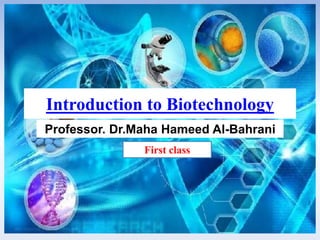
Introduction to Biotechnology lec1.zip.ppt
- 1. Introduction to Biotechnology Professor. Dr.Maha Hameed Al-Bahrani First class
- 2. Basic Concept on Biotechnology • After completing this lecture, you should be able to: • 1. Define biotechnology and understand the many scientific disciplines that contribute to biotechnology. • 2. Provide examples of historic and current applications of biotechnology and its products. • 3. List and describe different types of biotechnology and their applications.
- 3. What is Biotechnology • It is technology that utilizes biological systems, living organisms or parts of this to develop or create different products that help improve our lives. • The term biotechnology was first used by Karl Ereky in 1919, meaning “the production of products from raw materials with the aid of living organisms”. • Few of the selected science research areas contributing into the development of biotechnology are given in the Figure 1.
- 5. A Brief History of Biotechnology • In fact, many applications represent old practices with new methodologies shown in table 1. • The origins of biotechnology date back nearly 10,000 years ago when people were collecting plant seeds for planting the next year. There is evidence that Babylonians, Egyptians and Romans used these same selective breeding practices for improving livestock. • By 6000 B.C., beer, wine and bread were produced by fermentation. • By 4000 B.C., the Chinese used lactic acid bacteria to make yogurt, molds for making cheese and acetic acid bacteria to make vinegar. • Louis Pasteur is considered as the father of biotechnology by discovering that fermentation is performed by microorganisms
- 6. • Our early ancestors also took advantage of microorganisms used fermentation to make breads, cheeses, yogurts, and alcoholic beverages such as beer and wine. • During fermentation, some strains of yeast decompose sugars to derive energy, and in the process they produce ethanol (alcohol) as a waste product. • When bread dough is being made, yeast (Saccharomyces cerevisiae, commonly called baker’s yeast) is added to make the dough rise. This occurs because the yeast ferments sugar- releasing carbon dioxide, which causes the dough to rise and creates holes in the bread.
- 7. • One of the most widespread and commonly understood applications of biotechnology is the use of antibiotics. • In 1928, Alexander Fleming discovered that the mold Penicillium inhibited the growth of a bacterium called Staphylococcus aureus, which causes skin disease in humans. Subsequent work by Fleming led to the discovery and purification of the antibiotic penicillin • Antibiotics are substances produced by microorganisms that will inhibit the growth of other microorganisms.
- 8. • Since the 1960s, rapid development of our understanding of genetics and molecular biology has led to exciting new innovations and applications in biotechnology. • New technologies have led to gene cloning, the ability to identify and reproduce a gene of interest, and genetic engineering, manipulating the DNA of an organism. • Through genetic engineering, scientists are able to combine DNA from different sources. This process, called recombinant DNA technology, is used to produce many proteins of medical importance, including insulin, human growth hormone, and blood-clotting factors.
- 9. Table 1. : Important milestones of Biotechnology
- 11. Branches of biotechnology • The definition of biotechnology can be further divided into different areas known as red, green blue and white. • Gold biotechnology: Bioinformatics is a field that addresses biological problems using computational techniques • Red biotechnology: This area includes medical procedures such as utilizing organisms for the production of novel drugs Green biotechnology: Green biotechnology is biotechnology applied to agricultural processes. An example would be the selection and domestication of plants via micropropagation. transgenic plants to grow under specific environments in the presence (or absence) of chemicals
- 12. • Blue biotechnology is based on the exploitation of sea resources to create products and industrial applications. • White biotechnology, also known as industrial biotechnology, is biotechnology applied to industrial processes. An example is the designing of an organism to produce a useful chemical. • Yellow biotechnology" refers to the use of biotechnology in food production, for example in making bread, cheese, and beer by fermentation. • Gray biotechnology is dedicated to environmental applications, and focused on the maintenance of biodiversity and the remotion of pollutants.
- 13. Branches of biotechnology • Brown Biotechnology is related to the management of arid lands and deserts. • Violet biotechnology is related to law, ethical and philosophical issues around biotechnology. • Dark biotechnology is the color associated with bioterrorism or biological weapons and biowarfare which uses microorganisms, and toxins to cause diseases and death in humans, livestock and crops.
- 14. Branches of biotechnology Applications Term Bioinformatics and Nanotechnology Gold Health ,Medical and Diagnostics Red Agricultural processes Green Aquaculture, Coastal and Marine Blue Industrial processes White Food production Yellow Environmental applications, Grey Desert Brown Law, ethical and philosophical issues Violet Biowarfare Dark